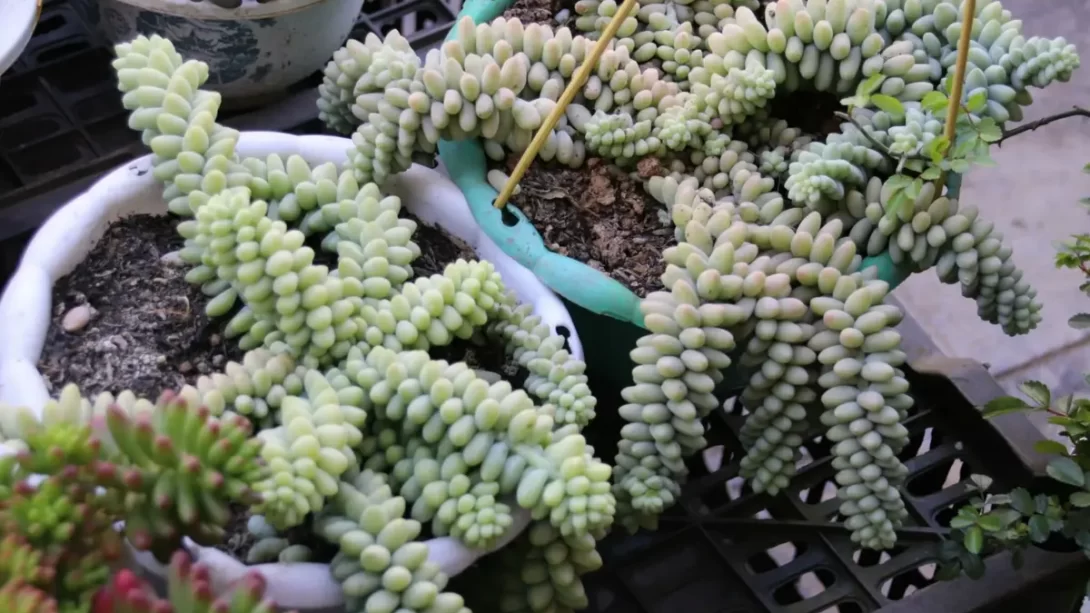The Burro’s Tail (Sedum morganianum), with its cascading tendrils of plump, green leaves, is a stunning succulent that adds a unique charm to any indoor garden. Many enthusiasts seek a fuller look for their Burro’s Tail, aiming to enhance its lush, trailing appearance. Achieving this requires understanding the plant’s needs and addressing common challenges such as sparse growth, leggy stems, or leaf drop. This guide will provide essential tips and techniques to help you cultivate a more robust and voluminous Burro’s Tail.
Burro’s Tail Growth Habits
Burro’s Tail typically grows long, trailing stems covered densely with teardrop-shaped leaves. This succulent is naturally inclined to produce a full and trailing appearance, but several factors can impact its fullness. These include lighting, watering, the right soil mix, and general care. Recognizing these factors and how they influence growth is fundamental to achieving the lush, full look desired for your Burro’s Tail.
Optimal Lighting Conditions
Light is a critical factor in the growth of Burro’s Tail. This succulent thrives in bright, indirect sunlight. When exposed to sufficient light, the plant maintains a compact form and produces more leaves, leading to a fuller appearance. Place your Burro’s Tail in a location where it can receive plenty of light, but avoid direct, harsh sunlight, which can scorch the leaves. South or west-facing windows are often ideal, but in very bright climates, some afternoon shade may be necessary. If natural light is limited, consider using a grow light to supplement.
Proper Watering Techniques
Watering plays a pivotal role in the health and fullness of Burro’s Tail. Over-watering can lead to root rot and leaf drop, while under-watering can cause the plant to conserve energy and produce fewer leaves. The soak-and-dry method is highly effective for succulents. Allow the soil to dry out completely between waterings, and then water deeply, ensuring excess water drains out. This method encourages strong root growth, which in turn supports fuller foliage development.
Appropriate Potting Mix and Container
For a fuller Burro’s Tail, the right potting mix and container are essential. This succulent prefers a well-draining soil mix to prevent water retention and root rot. A commercial cactus and succulent mix, possibly amended with perlite or coarse sand, works well. The container should also have adequate drainage holes. While Burro’s Tail can be kept in a relatively small pot to restrict root growth and encourage fuller foliage, ensure the pot is not overly restrictive, as this can stress the plant and impede its overall health.
Pruning and Propagation
Pruning is an effective way to encourage a fuller Burro’s Tail. Trimming back the ends of the stems can stimulate the plant to produce new side shoots, leading to a bushier appearance. Use clean, sharp scissors or pruning shears, and make cuts near a leaf node. The removed stem sections can be used for propagation – simply allow the cut ends to callous over for a few days, then place them in well-draining soil. This not only helps in achieving a fuller plant but also in multiplying your collection.
Fertilizing for Optimal Growth
Fertilizing is another key aspect of encouraging fuller growth in Burro’s Tail. Use a balanced, water-soluble fertilizer diluted to half the recommended strength. Fertilize during the growing season (spring and summer) once every month. Avoid over-fertilizing, as this can lead to rapid, weak growth and increased susceptibility to pests and diseases. The right amount of nutrients will support healthy, dense foliage and promote the overall vigor of the plant.
Dealing with Pests and Diseases
A healthy Burro’s Tail is less likely to succumb to pests and diseases, which can affect its fullness. Common issues include mealybugs and aphids. Inspect your plant regularly and treat any infestations promptly with insecticidal soap or neem oil. Good air circulation and avoiding water on the leaves can help prevent fungal diseases. Keeping the plant in optimal growing conditions will strengthen its natural defenses against such problems.
Regular Maintenance and Care
Consistent care is essential for maintaining a full and vibrant Burro’s Tail. Regularly inspect the plant for any signs of stress or disease. Remove any dead or dying leaves to encourage new growth and improve air circulation around the plant. Also, be mindful of the plant’s seasonal needs. During winter, when the plant is dormant, reduce watering significantly and refrain from fertilizing. This rest period is crucial for the plant’s health and contributes to vigorous growth in the growing season.
Seasonal Adjustments in Care
Understanding the seasonal needs of Burro’s Tail will help in maintaining its fullness year-round. In spring and summer, the plant actively grows and benefits from more frequent watering and monthly fertilizing. However, in fall and winter, as growth slows, reduce watering and stop fertilizing. If you’re in a region with low winter light, consider providing supplemental light to prevent the plant from becoming leggy.
Repotting for Continued Health
While Burro’s Tail doesn’t need frequent repotting, doing so every 2-3 years can contribute to a fuller plant. Repotting provides fresh soil and more room for root growth, which in turn supports healthier, more robust foliage. When repotting, be gentle with the fragile stems and leaves, and choose a pot only slightly larger than the previous one, as too much space can encourage more root growth at the expense of foliage.
Conclusion
Creating a fuller Burro’s Tail plant requires patience, understanding of the plant’s needs, and consistent care. By providing optimal lighting, proper watering, the right soil mix, and timely pruning and fertilization, you can encourage your Burro’s Tail to grow lush and dense. Remember that each plant is unique and may respond differently to care routines, so be observant and adjust your practices as needed. With time and attention, your Burro’s Tail can transform into a beautifully full and cascading succulent, adding a striking element to your indoor garden.



